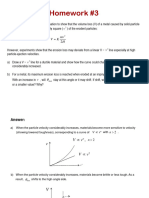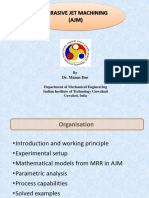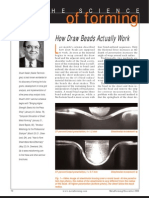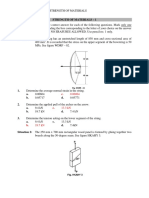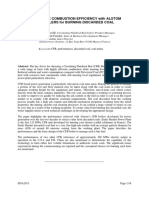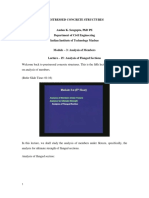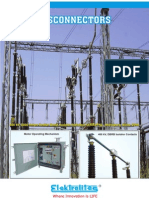Reap Poster
Reap Poster
Uploaded by
api-337827496Copyright:
Available Formats
Reap Poster
Reap Poster
Uploaded by
api-337827496Original Title
Copyright
Available Formats
Share this document
Did you find this document useful?
Is this content inappropriate?
Copyright:
Available Formats
Reap Poster
Reap Poster
Uploaded by
api-337827496Copyright:
Available Formats
Pressure Shear Plate Impact on Granular Boron Carbide
Steven Hu, Alex X. Sun, K.T. Ramesh
Centennial High School, Ellicott City, MD;
Johns Hopkins University | Whiting School of Engineering | Baltimore, MD
Abstract Research and Discussion
Boron carbide is investigated in current work due to its Figure 1: Laser Line Velocity Figure 2: X-t Diagram Figure 3: Interferometer Data
excellent mechanical strength and low density, which are
key features for structural application such as armor
protection and penetration prevention. However, its
plasticity is negligible making commercial boron carbide a
Velocity (µ/s)
very brittle material in which crack nucleation, crack
propagation, fragmentation, and dynamic granular flow are
the dominant deformation mechanisms, especially at high
strain rates and complex stress states. Granular flow in Displacement (mm)
communized zones has critical effects on ballistic Approximately Shear wave speed in plate cs: 3264 m/s
performance of armor materials. In this experiment, the Longitudinal wave speed in plate cd: 5983 m/s
78 m/s
granular boron carbide ESK3000F (with an average grain Wave speed for granular material
size of 0.7 microns) is subject to ultra-high-strain-rate
loading conducted by pressure shear plate impact Figure 4: Dynamic Shear Response
experiment. The granular boron carbide is deformed at a
shearing rate of about 2x104s-1 with a superimposed
normal pressure at 1.74GPa. The obtained shear stress is
around 270MPa. From the collected and analyzed data, the
granular shear stress increases with increasing normal
pressure. Also, by analyze shear strain rate, normal
𝑡1 𝑡2 𝑡3
pressure has stronger effects than the shear strain rate on Added delay time due to tilt
granular shear stress.
The shear window is less than 2 𝜇s
Methods 1
𝜏𝑠 = 𝜌𝑐𝑠 𝑣𝑓𝑠 𝑣0 −𝑣𝑓𝑠
2 𝛾 =
Pressure Shear Plate Impact 1 ℎ Results
Projectile 𝜎 = 𝜌𝑐𝑑 𝑣𝑓 ≈ 1.74GPa
Specimen 2
Successfully completed one pressure shear plate
Shear strain rate is 2 × 10 𝑠 4 −1
Grating Shear strength is 270 impact experiment on granular boron carbide
TDI
MPa
𝑢0 NVI/NDI Measured shear stresses in the granular flow at
𝑣0
Incident Beam Figure 5: Normal Pressure Effects around 270 Mpa, normal stresses at around 1.74
V
Gpa, and shear rates of 2x104 s-1.
TDI
Pressure has a At high rates, increasing the pressure increases the
strong effect on the shear stress sustained by the granular material.
Wedge Flyer Target shear stress Pressure effects are stronger than strain rate effects.
Internal friction
coefficient is
Acknowledgements
approximately 0.16 Army Engineering Outreach Program—Research and
Engineering Apprenticeship Program
Early time behavior likely due to shear wave propagation through Ramesh Lab of John’s Hopkins University: Alex Sun
granular medium
and K.T. Ramesh
You might also like
- Astm d624 Pdqv6897Document9 pagesAstm d624 Pdqv6897Nayth Andres GalazNo ratings yet
- Fracture and Fatigue Is 2019 ClassDocument58 pagesFracture and Fatigue Is 2019 ClassTejaarka PiridiNo ratings yet
- Lecture 6Document19 pagesLecture 6Iftekhar ArefinNo ratings yet
- 04 FractureDocument25 pages04 FractureMücahit YaylaNo ratings yet
- Lec 6Document30 pagesLec 6Pejman HNo ratings yet
- Unit 4-Mech. Behaviour of MaterialsDocument5 pagesUnit 4-Mech. Behaviour of MaterialsNaruto FanNo ratings yet
- Prediction of Impact Damage in Composite Plates: J.P. Hou, N. Petrinic, C. Ruiz, S.R. HallettDocument9 pagesPrediction of Impact Damage in Composite Plates: J.P. Hou, N. Petrinic, C. Ruiz, S.R. HallettVeeturiVarunNo ratings yet
- Slides 4 - Internal StressDocument12 pagesSlides 4 - Internal StressMarceloNo ratings yet
- Preparation of Papers For IEEE Sponsored Conferences and Symposia 4Document13 pagesPreparation of Papers For IEEE Sponsored Conferences and Symposia 4harsha festyNo ratings yet
- FractureDocument42 pagesFractureRaj BhirudNo ratings yet
- 5968079sheet Metal OperationsDocument6 pages5968079sheet Metal OperationsMd Irfan AnsariNo ratings yet
- Homework Selection of MaterialsDocument2 pagesHomework Selection of MaterialsJ7C2No ratings yet
- Fracture Gradient Prediction Zhang y Yin PAPER PDFDocument11 pagesFracture Gradient Prediction Zhang y Yin PAPER PDFalvarodimassimo04No ratings yet
- Failure of SolidsDocument22 pagesFailure of Solidszab348168No ratings yet
- 1 Adhesive TapeDocument35 pages1 Adhesive TapeAhmad AlShahrourNo ratings yet
- Friction Pressure Management in Hydraulic Fracturing OperationDocument2 pagesFriction Pressure Management in Hydraulic Fracturing OperationKamal HamzahNo ratings yet
- Hoseinpour-Riahi2022 Article DeterminationOfTheMudWeightWinDocument20 pagesHoseinpour-Riahi2022 Article DeterminationOfTheMudWeightWinbuatiatmiNo ratings yet
- Laboratory Stress-Strain Tests For Developments in Geotechnical Engineering Research and PracticeDocument61 pagesLaboratory Stress-Strain Tests For Developments in Geotechnical Engineering Research and PracticeRami Mahmoud BakrNo ratings yet
- A Simplified Model of Brazier Effect in Plastic Bending of Cylindrical TubesDocument10 pagesA Simplified Model of Brazier Effect in Plastic Bending of Cylindrical TubesPirulito PinpinNo ratings yet
- Determination of The Most Important Grinding Mechanism in StirredDocument7 pagesDetermination of The Most Important Grinding Mechanism in Stirred王柏昆No ratings yet
- Presentation 10Document14 pagesPresentation 10riya.3No ratings yet
- Physical Interpretation of Grain Refinement-Induced Variation in Fracture Mode in Ferritic SteelDocument3 pagesPhysical Interpretation of Grain Refinement-Induced Variation in Fracture Mode in Ferritic Steelvladimirsoler01No ratings yet
- The Field Vane Shear Test PDFDocument5 pagesThe Field Vane Shear Test PDFramNo ratings yet
- The Field Vane Shear TestDocument5 pagesThe Field Vane Shear TestramNo ratings yet
- Pertemuan Kedua Dan Ketiga AKMDocument45 pagesPertemuan Kedua Dan Ketiga AKMJohan NicholasNo ratings yet
- DT Fracture TestDocument4 pagesDT Fracture TestEngAhmedEl-NamlNo ratings yet
- Lecture 10 Fracture MechanicsDocument21 pagesLecture 10 Fracture Mechanicsantoine demeire100% (3)
- FractureDocument30 pagesFracturebharath_rhjNo ratings yet
- Fatigue Damage Evaluation of A High Pressure Tube Steel Using Cyclic Strain Energy DensityDocument8 pagesFatigue Damage Evaluation of A High Pressure Tube Steel Using Cyclic Strain Energy DensityAdnen LaamouriNo ratings yet
- Bonga University: Engineering Material (Meng2091)Document32 pagesBonga University: Engineering Material (Meng2091)Mul'isaa JireenyaaNo ratings yet
- Vol19b 0925Document17 pagesVol19b 0925Walaa Hassan Salem Abd El KareemNo ratings yet
- Abrasive Jet Machining (AJM) : Dr. Manas DasDocument40 pagesAbrasive Jet Machining (AJM) : Dr. Manas DasVicky Bawa-127No ratings yet
- Interphase Transport in Isothermal SystemDocument25 pagesInterphase Transport in Isothermal SystemMuhammad Yuzer IrosoneriNo ratings yet
- Failure in MaterialDocument22 pagesFailure in Materialnur afifahNo ratings yet
- CH 09Document67 pagesCH 09TamiruNo ratings yet
- Calculation of Shear Band Thickness in Sensitive Clays: H.P. Jostad & L. AndresenDocument6 pagesCalculation of Shear Band Thickness in Sensitive Clays: H.P. Jostad & L. AndresenLaboratoire LTGCNo ratings yet
- Design For Fracture: Lecture Two Lect. Dr. Hind B. Al-AttraqchiDocument35 pagesDesign For Fracture: Lecture Two Lect. Dr. Hind B. Al-AttraqchiTRNADEWNo ratings yet
- Metal Forming Processes - FullDocument91 pagesMetal Forming Processes - FullmohammadNo ratings yet
- Pool1986 PDFDocument12 pagesPool1986 PDFankushNo ratings yet
- MAK 4032E 4th Week Ver6 English Version5Document10 pagesMAK 4032E 4th Week Ver6 English Version5Bünyamin TatarNo ratings yet
- 3 MergedDocument24 pages3 MergedPratik GhoshNo ratings yet
- ( (2008) Wu WT Al.) - Effects of Specimen Size and Some Other Factors On The Strength and Deformation of Granular Soil in Direct Shear TestsDocument21 pages( (2008) Wu WT Al.) - Effects of Specimen Size and Some Other Factors On The Strength and Deformation of Granular Soil in Direct Shear TestsLAM TRAN DONG KIEMNo ratings yet
- Metal Forming - IitgDocument91 pagesMetal Forming - IitgpriyanjanrajofficialNo ratings yet
- Lofgren PaperNordicminiseminarFRC 2007Document13 pagesLofgren PaperNordicminiseminarFRC 2007Hemantha BalasuriyaNo ratings yet
- ستيل ستركشرDocument73 pagesستيل ستركشرAws SamaNo ratings yet
- FatigueDocument22 pagesFatigueimabdullah6No ratings yet
- Borehole Instability ExtendedDocument67 pagesBorehole Instability ExtendedIon Marin100% (1)
- Buckling of Stiffened Panels and Its Mitigation-Mandal-2014Document7 pagesBuckling of Stiffened Panels and Its Mitigation-Mandal-2014DonatasNo ratings yet
- Numerical Investigations of Crack-Tip Constraint Parameters in Two-Dimensional GeometriesDocument11 pagesNumerical Investigations of Crack-Tip Constraint Parameters in Two-Dimensional GeometriesSRIKANTH K 15PHD1093No ratings yet
- Cutting Force On A Diamond Grit in StoneDocument8 pagesCutting Force On A Diamond Grit in StoneDaniel MoravanskýNo ratings yet
- Draw BeadDocument2 pagesDraw Beadaruanand143No ratings yet
- Tensile TestingDocument9 pagesTensile TestingkNo ratings yet
- Experimental Investigation On Screw Reinforcement of Timber Members Under Compression Perpendicular To The GrainDocument15 pagesExperimental Investigation On Screw Reinforcement of Timber Members Under Compression Perpendicular To The Grainhtkd1206No ratings yet
- Metals: Fatigue Crack Growth Behavior of Austempered AISI 4140 Steel With Dissolved HydrogenDocument18 pagesMetals: Fatigue Crack Growth Behavior of Austempered AISI 4140 Steel With Dissolved HydrogenAjeeth KumarNo ratings yet
- Ductile Fracture & Brittle Fracture PDFDocument39 pagesDuctile Fracture & Brittle Fracture PDFkoontattNo ratings yet
- Processing of Aerospace Materials - I (ME772) : Fracture Toughness and High Cycle Fatigue Date: 11 January 2022Document23 pagesProcessing of Aerospace Materials - I (ME772) : Fracture Toughness and High Cycle Fatigue Date: 11 January 2022B RITHIKANo ratings yet
- Chapter 5, Part B Failure Modes: MET 210W E. Evans/ R.MichaelDocument47 pagesChapter 5, Part B Failure Modes: MET 210W E. Evans/ R.MichaelabadittadesseNo ratings yet
- ForgingDocument23 pagesForgingRajeev RanaNo ratings yet
- Cini, Irving - 2017 - Development of Fatigue Cracks From Mechanically Machined Scratches On 2024-T351 Aluminium Alloy-Part II Finite EleDocument16 pagesCini, Irving - 2017 - Development of Fatigue Cracks From Mechanically Machined Scratches On 2024-T351 Aluminium Alloy-Part II Finite EleJoana AntunesNo ratings yet
- JamshedpurDocument20 pagesJamshedpurabhishek panchalNo ratings yet
- JotunDocument5 pagesJotunraza.slietNo ratings yet
- Study of Rayleigh-B Enard-Brinkman Convection Using LTNE Model and Coupled, Real Ginzburg-Landau EquationsDocument8 pagesStudy of Rayleigh-B Enard-Brinkman Convection Using LTNE Model and Coupled, Real Ginzburg-Landau EquationsDebuNo ratings yet
- TLW NotesDocument138 pagesTLW Noteshakkem bNo ratings yet
- Experiment 2 PhysicsDocument5 pagesExperiment 2 Physicsansh Beniwal0% (1)
- The Transportation Lag: X (T) X (T-X (S) X(S)Document9 pagesThe Transportation Lag: X (T) X (T-X (S) X(S)ashish guptaNo ratings yet
- Proposal 1Document14 pagesProposal 1calebpetersenscribdNo ratings yet
- April 14Document7 pagesApril 14rossana rondaNo ratings yet
- IRS Draft Handbook On Selection of Welding ElectrodesDocument15 pagesIRS Draft Handbook On Selection of Welding ElectrodesSiva Prasad MamillapalliNo ratings yet
- Review Problems in Strength of MaterialsDocument10 pagesReview Problems in Strength of MaterialsJenesis de Guzman50% (2)
- ElementsDocument1 pageElementsjose riNo ratings yet
- Alstom BFB PDFDocument18 pagesAlstom BFB PDFNaveed RabbaniNo ratings yet
- Cambridge IGCSE: PHYSICS 0625/63Document12 pagesCambridge IGCSE: PHYSICS 0625/63Maram MohanNo ratings yet
- 斯坦福大学机器学习数学基础 1-8Document8 pages斯坦福大学机器学习数学基础 1-82285145156No ratings yet
- Is 14399 1-2 1996Document27 pagesIs 14399 1-2 1996amjadmalik75No ratings yet
- List of Functional Locally Improvised ApparatusDocument14 pagesList of Functional Locally Improvised ApparatusDenver GuillermoNo ratings yet
- MEC321P Thermal Engineering Practice Expt-1: Performance Study of Solar Water HeaterDocument2 pagesMEC321P Thermal Engineering Practice Expt-1: Performance Study of Solar Water Heaterm sriNo ratings yet
- Prestressed Concrete StructuresDocument37 pagesPrestressed Concrete StructuresVivek ShuklaNo ratings yet
- 8.2 Orthogonal MatricesDocument3 pages8.2 Orthogonal MatricesJosephKuoNo ratings yet
- Structural Dynamics - WebDocument3 pagesStructural Dynamics - WebVhong NeoNo ratings yet
- Relay - Response - To - Motor - Residual - Voltage - During - Automatic - TransfersDocument8 pagesRelay - Response - To - Motor - Residual - Voltage - During - Automatic - Transfersreachyourdreams30No ratings yet
- 729 Simplified Model of Heat Loss in A Coffee Cup PDFDocument4 pages729 Simplified Model of Heat Loss in A Coffee Cup PDFAdamSultansyahNo ratings yet
- EE037-3.5-2 EPU L16 Electric Braking-P1Document11 pagesEE037-3.5-2 EPU L16 Electric Braking-P1Neeraj NagaNo ratings yet
- Premium Performance Ultrasound: Bringing To The Whole PictureDocument12 pagesPremium Performance Ultrasound: Bringing To The Whole Pictureamargupta8819100% (3)
- A Review of High-Strength Wear-Resistant Steel-HardoxDocument8 pagesA Review of High-Strength Wear-Resistant Steel-HardoxakhileshNo ratings yet
- Alpha Project Services Private Limited: BarodaDocument29 pagesAlpha Project Services Private Limited: BarodaNehal Vaghela100% (2)
- List of Courses Available in All Iits and Ism Dhanbad: SN ProgrammeDocument4 pagesList of Courses Available in All Iits and Ism Dhanbad: SN ProgrammeMithun TarapureddiNo ratings yet
- Worksheet Chapter 1. Physical Quantities, Units and MeasurementDocument5 pagesWorksheet Chapter 1. Physical Quantities, Units and MeasurementMCH50% (2)
- Dis ConnectorsDocument4 pagesDis ConnectorssaravanakumartbNo ratings yet
- 121205Document25 pages121205wdavid81No ratings yet




